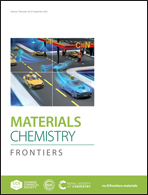Versatile π-bridges in nonfullerene electron acceptors of organic solar cells
Abstract
The development of nonfullerene electron acceptors (NFEAs) is a landmark advance in the field of organic solar cells (OSCs). To achieve better light utilization and greater efficiencies of acceptor–donor–acceptor (A–D–A) type and analog acceptors, various decorations of central π-backbones, side chains, and endcaps have been intensively conducted, which has promoted the power conversion efficiencies (PCEs) to over 19% in single bulk-heterojunction (BHJ) solar cells recently. Among the multiple decoration approaches, π-bridge engineering provides a facile but effective strategy to manipulate the molecular energy levels, photo-physical properties, molecular aggregation, and the final photovoltaic performance. The π-bridge strategy has received long-term attention and achieved marvellous progress with respect to increasing the PCE and expanding the applications of NFEAs. However, the efficiencies of π-bridged acceptors are still far behind those of their rigid counterparts at this stage. Despite the great challenges, the intrinsic merits of π-bridges provide great potential to mark a breakthrough in PCE, by rationally designing and employing the π-bridge strategy in the design of NFEAs. Meanwhile, the high availability of π-bridges for constructing ultra-small bandgap acceptors with intense near-infrared (NIR) absorptivity provides a great basis for NIR-related organic devices, for example, the tandem OSCs, semitransparent organic solar cells (ST-OSCs), and organic photodetectors (OPDs). In this review, we first screened the development of typical π-bridged small molecular acceptors in different NFEA communities, attempting to confirm the advantages and disadvantages of the current π-bridged NFEAs. In the end, the current challenges and possible strategies for π-bridge engineering in advancing the development of NFEAs are discussed, from the viewpoints of PCE breakthroughs, NIR-absorbing acceptors, and critical conformation interconversion in the family of π-bridged NFEAs.

- This article is part of the themed collections: 2023 Materials Chemistry Frontiers Review-type Articles and 2023 Materials Chemistry Frontiers HOT articles


 Please wait while we load your content...
Please wait while we load your content...